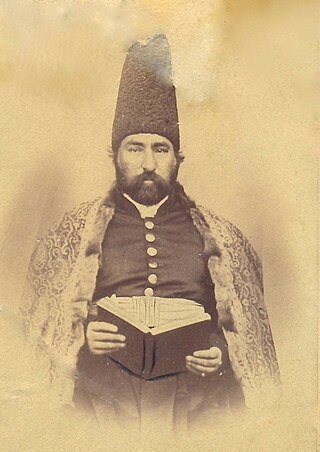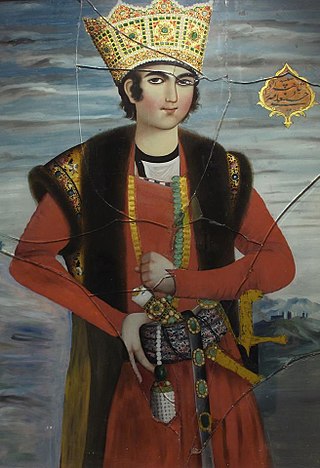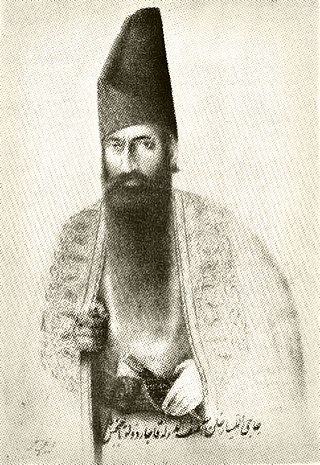
Mohammad Shah was the third Qajar shah of Iran from 1834 to 1848, inheriting the throne from his grandfather, Fath-Ali Shah. From a young age, Mohammad Mirza was under the tutelage of Haji Mirza Aqasi, a local dervish from Tabriz whose teachings influenced the young prince to become a Sufi-king later in his life. After his father Abbas Mirza died in 1833, Mohammad Mirza became the crown prince of Iran and was assigned with the governorship of Azarbaijan. After the death of Fath-Ali Shah in 1838, some of his sons including Hossein Ali Mirza and Ali Mirza Zel as-Soltan rose up as claimants to the throne. With the support of English and Russian forces, Mohammad Shah suppressed the rebellious princes and asserted his authority.

Fath-Ali Shah Qajar was the second Shah (king) of Qajar Iran. He reigned from 17 June 1797 until his death on 24 October 1834. His reign saw the irrevocable ceding of Iran's northern territories in the Caucasus, comprising what is nowadays Georgia, Dagestan, Azerbaijan, and Armenia, to the Russian Empire following the Russo-Persian Wars of 1804–1813 and 1826–1828 and the resulting treaties of Gulistan and Turkmenchay. Historian Joseph M. Upton says that he "is famous among Iranians for three things: his exceptionally long beard, his wasp-like waist, and his progeny."

Mozaffar ad-Din Shah Qajar, was the fifth Qajar shah (king) of Iran, reigning from 1896 until his death in 1907. He is often credited with the creation of the Persian Constitution of 1906, which he approved of as one of his final actions as shah.

Mohammad-Ali Mirza Dowlatshah was a famous Iranian Prince of the Qajar dynasty. He is also the progenitor of the Dowlatshahi Family of Persia. He was born at Nava, in Mazandaran, a Caspian province in the north of Iran. He was the first son of Fath-Ali Shah, the second Qajar king of Persia, and Ziba Chehr Khanoum, a Georgian girl of the Tsikarashvili family. He was also the elder brother of Abbas Mirza. Dowlatshah was the governor of Fars at age 9, Qazvin and Gilan at age 11, Khuzestan and Lorestan at age 16, and Kermanshah at age 19.

Mirza Abol-Qasem Qa'em-Maqam Farahani, also known as Qa'em-Maqam II, was an Iranian official and prose writer, who played a central role in Iranian politics in first half of the 19th-century, as well as in Persian literature.

Bahman Mirza was a Qajar prince, literary scholar, and writer who lived in Iran and later the Russian Empire. The fourth son of the former crown prince Abbas Mirza, his career in Iran was marked by several governorships, including the province of Azerbaijan (1841–1847).

Prince Khosrow Mirza Qajar was the seventh son of Abbas Mirza and grandson of Fath-Ali Shah, King of Iran.

Bahram Mirza Moezz-od-Dowleh was a Qajar prince, statesman and governor in 19th-century Iran. The second son of the crown prince Abbas Mirza, he served as the Minister of Justice from 1878 until his death on 21 October 1882.

Mirza Abolhassan Khan Ilchi was an Iranian politician and diplomat who served as the Minister of Foreign Affairs twice, first from 1824 to 1834, and then again from 1838 until his death in 1845. He also served as the ambassador to Russia and Britain, and was the main Iranian delegate at the signing of the Golestan and Turkmenchay treaties with Russia in 1813 and 1828 respectively.

Jalal al-Din Mirza was an Iranian historian and freethinker, born in Tehran. He wrote a semi-historical book about the history of Iran named Name-ye Khosrovan, potentially one of the first comprehensive nationalistic works about the country.

Hajji Ebrahim Shirazi, also known by his honorific title E'temad ol-Dowleh, was an Iranian statesman who served as the kalantar of the city of Shiraz during the late Zand era and later as the first grand vizier of Qajar Iran.

Abu'l-Hasan Khan Ghaffari Kashani was an Iranian painter, miniature and lacquer artist, and book illustrator. When he became the Chief Court Painter, he also became known as Sani al-Mulk (صنیعالملک), meaning "The Crafter of the Kingdom." He was a student of Mihr Ali and a court painter in Mohammad Shah Qajar's court. After being dismissed as a court painter, he went to Europe to study, most notably in Italy. When he returned to Iran, he became the Director of Printing and Chief Illustrator for Nasir al-Din Shah and earned the separate title Chief Court Painter. He supervised the illustration of a famous One Thousand and One Nights manuscript, which can be viewed today in Tehran in the Golestan Palace Library.

Mirza Isa Farahani, commonly known as Mirza Bozorg Qa'em-Maqam, was an Iranian official, who played a leading role in the politics of early 19th-century Qajar Iran. He was the father of the distinguished politician and writer Abol-Qasem Qa'em-Maqam.

Hossein Ali Mirza, a son of Fath-Ali Shah, was the Governor of Fars and pretender to the throne of Qajar Iran.

Ali Akbar Qavam ol-Molk was an Iranian statesman who served as the kalantar of Shiraz and Custodian of Astan Quds Razavi in the Qajar period. He was the youngest son of Hajji Ebrahim Shirazi, the grand vizier of Fath-Ali Shah who by the latter's order was executed, his family too, subsequently purged. Ali Akbar was one of the survivors. Later for appeasement by the orders of Fath-Ali Shah, his family lands were returned and he became the kalantar of Shiraz, thus marking the start of Qavam family.

The Second Herat War was the invasion of the surrounding realm of Herat and the successful siege of its citadel by the Qajar army led by Hesam o-Saltaneh, Soltan Morad Mirza. The 1856 siege was part of the concerted Qajar effort to compensate the recent territorial losses in the Russo-Persian Wars of 1804–1813 and 1826–1828 by reconquering western Afghanistan, which had historically been a part of Persia's domain. The conflict was also a part of the broader Great Game between the British Empire and the Russian Empire.
Mirza Mohammad Taqi Sepehr, also known as Mirza Mohammad Taqi Kashani, or with the honorific Lesan ol-Molk, was an Iranian court historian and littérateur of the Qajar era. He wrote with the pen name Sepehr, and is known for authoring the lengthy Persian chronicle Nasekh ol-tavarikh-e salatin-e Qajariyeh, also simply known as the Nasekh ol-tavarikh.

Allahyar Khan Devellu-Qajar Asef al-Dowleh was the prime minister of Qajar Iran under shah (king) Fath-Ali Shah Qajar from 1824 to 1828.
Mirza Asadollah Nuri was an Iranian official who served as the revenue officer under the first two Qajar shahs (kings) of Iran, Agha Mohammad Khan Qajar and Fath-Ali Shah Qajar. He belonged to the prominent Khajeh Nouri family of Nur district in the region of Mazandaran. He was the father of Mirza Aqa Khan Nuri, who served as the prime minister under Naser al-Din Shah Qajar from 1851 to 1858.

Fath-Ali Khan Saba was a court poet under Fath-Ali Shah Qajar, who dedicated an imitation of the Persian epic poem Shahnameh to him, entitled Shahanshah-nameh.



















